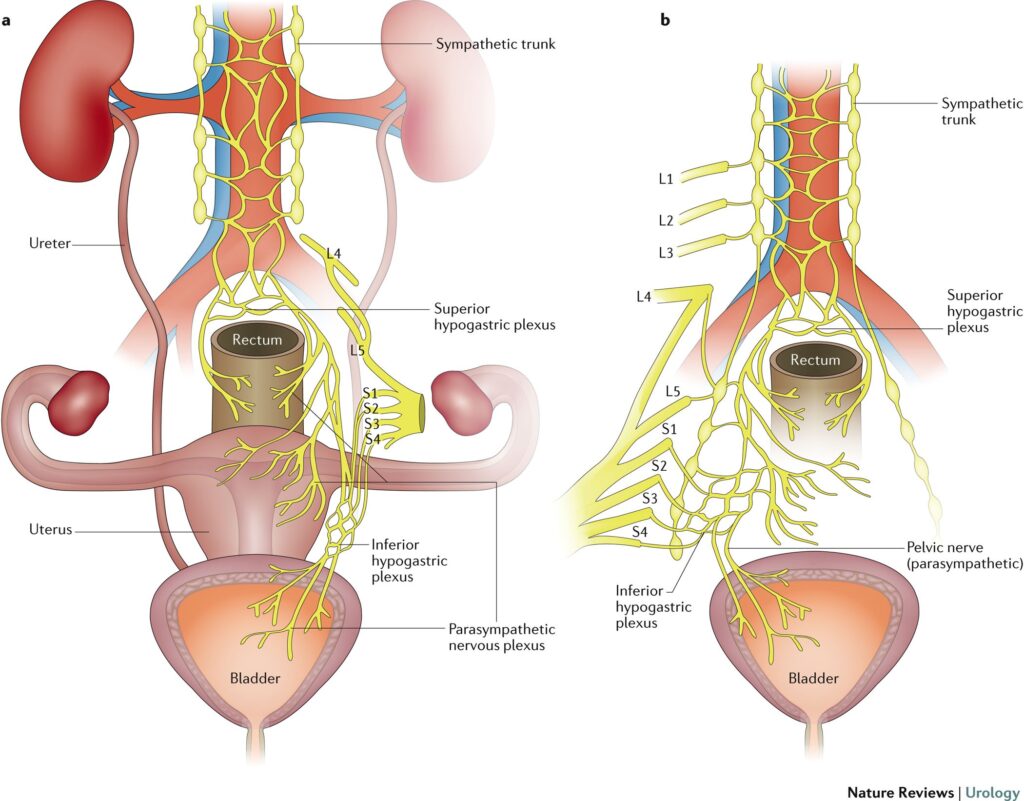
Endometriosis, a condition where tissue similar to the uterine lining grows outside the uterus, can affect various areas of the body.
One such uncommon yet significant site is the ureter, the tube responsible for transporting urine from the kidneys to the bladder.
This article explores Ureteral Endometriosis, a rare but challenging condition that can lead to serious complications for those affected.
In most cases, endometrial nodules form around the ureter, resulting in extrinsic compression. However, intrinsic compression—where the endometriotic tissue invades the ureter itself—is less common but still possible.
Endometriosis of the Ureter: Symptoms, Diagnosis, and Treatment
✅ What is Ureteral Endometriosis?
Ureteral endometriosis is a rare form of endometriosis in which endometrial-like tissue grows on or around the ureters—the tubes that connect the kidneys to the bladder. This abnormal growth can lead to ureteral obstruction, causing complications such as hydronephrosis (swelling of the kidney), impaired kidney function, and in severe cases, kidney failure.
It is estimated that 1-4% of women with endometriosis develop ureteral involvement, but it is often underdiagnosed due to its subtle symptoms.
🔎 Types of Ureteral Endometriosis
Ureteral endometriosis is classified into two types based on the location of the endometrial lesions:
✅ 1. Intrinsic Ureteral Endometriosis:
- Endometrial tissue grows inside the ureter.
- Causes narrowing and obstruction of the ureteral lumen.
- More aggressive and difficult to treat.
✅ 2. Extrinsic Ureteral Endometriosis:
- Endometrial-like tissue grows on the outer surface of the ureter.
- Leads to compression and partial blockage.
- More common than intrinsic ureteral endometriosis.
🔥 Symptoms of Ureteral Endometriosis
The symptoms of ureteral endometriosis vary depending on the severity of the ureteral involvement and the extent of kidney damage.
Common symptoms include:
✅ 1. Flank or Lower Back Pain:
- Persistent, dull, or sharp pain on one or both sides of the lower back or flank.
- Worsens during menstruation.
✅ 2. Pelvic or Abdominal Pain:
- Chronic pelvic pain, often mistaken for gynecological conditions.
- Pain may radiate to the groin or thighs.
✅ 3. Painful Urination (Dysuria):
- Burning or discomfort while urinating.
- May mimic urinary tract infections (UTIs).
✅ 4. Blood in the Urine (Hematuria):
- Pink or reddish-colored urine during menstruation.
- A sign of ureteral damage or inflammation.
✅ 5. Frequent or Urgent Urination:
- Increased frequency or urgency to urinate.
- Caused by bladder irritation due to ureteral involvement.
✅ 6. Decreased Urine Output:
- Blockage of the ureter reduces urine flow.
- May cause difficulty in passing urine.
✅ 7. Nausea and Vomiting:
- Seen in advanced cases due to kidney swelling or dysfunction.
✅ 8. Symptoms of Kidney Dysfunction:
- Swelling in the legs or face.
- Fatigue, fluid retention, and general weakness due to kidney impairment.
🔍 Diagnosis of Ureteral Endometriosis
Diagnosing ureteral endometriosis requires a combination of imaging tests, clinical evaluation, and sometimes surgery.
✅ 1. Medical History and Symptom Assessment:
- Review of symptoms like pelvic pain, urinary issues, and back pain.
- History of endometriosis or infertility raises suspicion.
✅ 2. Pelvic and Abdominal Examination:
- The doctor checks for tenderness or masses near the ureter or bladder.
- Pain during palpation may indicate endometriotic involvement.
✅ 3. Imaging Tests:
- Ultrasound (USG):
- First-line test to detect hydronephrosis (kidney swelling).
- May reveal ureteral dilation.
- Magnetic Resonance Imaging (MRI):
- Provides detailed images of the ureters, kidneys, and pelvic organs.
- Detects deep infiltrating endometriosis and ureteral compression.
- CT Urography or CT Scan:
- Evaluates the extent of ureteral obstruction.
- Helps in ruling out other urinary conditions.
✅ 4. Intravenous Pyelography (IVP):
- Contrast dye is injected to visualize the urinary tract.
- Identifies ureteral narrowing or blockages.
✅ 5. Cystoscopy and Ureteroscopy:
- Direct visualization of the ureter and bladder using a small camera.
- Helps detect intrinsic ureteral endometriosis.
✅ 6. Laparoscopy:
- Gold standard for confirming endometriosis diagnosis.
- Allows for visual inspection of the ureters.
- Enables biopsy of lesions for histopathological examination.
✅ 7. Kidney Function Tests:
- Serum creatinine and blood urea nitrogen (BUN) levels.
- Detects kidney impairment caused by ureteral obstruction.
💊 Treatment Options for Ureteral Endometriosis
Treatment for ureteral endometriosis focuses on:
- Relieving symptoms.
- Preventing kidney damage.
- Restoring ureteral function.
✅ 1. Medical Management:
- Hormonal Therapy:
- Used to suppress ovulation and reduce estrogen levels.
- Medications include:
- GnRH agonists (Leuprolide, Goserelin).
- Progestins (Dienogest, Norethindrone).
- Combined oral contraceptives (COCs).
- Pain Management:
- NSAIDs (ibuprofen, naproxen) for pain relief.
- Opioids may be used in severe cases.
✅ 2. Surgical Treatment:
- Laparoscopic Surgery:
- Minimally invasive surgery to remove endometrial lesions around the ureter.
- Used for mild to moderate cases.
- Ureterolysis:
- Involves freeing the ureter from endometriotic tissue.
- Helps restore normal urine flow.
- Ureterectomy and Ureteral Reimplantation:
- Required in severe cases with extensive ureteral damage.
- The damaged segment of the ureter is removed, and the healthy part is reimplanted into the bladder.
- Ureteral Stenting:
- Temporary stent placement to keep the ureter open.
- Reduces blockage and improves urine drainage.
- Nephrectomy (Kidney Removal):
- Rarely needed in cases of severe, irreversible kidney damage.
✅ 3. Fertility Preservation:
- For women with fertility concerns, fertility preservation techniques like oocyte cryopreservation (egg freezing) may be recommended before undergoing surgery.
✅ 4. Lifestyle and Dietary Modifications:
- Hydration and a low-sodium diet help support kidney function.
- Avoiding caffeine and alcohol reduces bladder irritation.
💡 Key Takeaway
Ureteral endometriosis is a rare but serious condition that can lead to ureteral obstruction, kidney dysfunction, and chronic pain. Early diagnosis through imaging and laparoscopy is crucial to prevent complications. Treatment involves a combination of hormonal therapy, pain management, and surgery to restore normal ureteral function and preserve kidney health. 🌿
